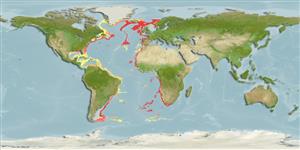Holocephali (chimaeras) >
Chimaeriformes (Chimaeras) >
Rhinochimaeridae (Longnose chimaeras)
Etymology: Rhinochimaera: A chimaera with rhinos (Gr.), nose, referring to long, pointed proboscis of R. pacifica (See ETYFish); atlantica: ana- (L.), belonging to: North Atlantic Ocean, where it occurs (See ETYFish).
Environment: milieu / climate zone / depth range / distribution range
Ecology
Marine; bathydemersal; depth range 200 - 1500 m (Ref. 117245), usually 400 - 1500 m (Ref. 4444). Deep-water; 67°N - 58°S, 98°W - 26°E
Northwest to Northeast Atlantic, and Southeast Atlantic: Antitropical. Eastern Atlantic: northern Bay of Biscay northward to Iceland, including the Iceland-Faroes Rise (Ref. 3183); off Cayar and Cape Barbas in Western Sahara, off Namibia and South Africa (Ref. 4444). Western Atlantic: off Nova Scotia, Canada and New England, USA (Ref. 3183).
Size / Weight / Age
Maturity: Lm ? range ? - ? cm
Max length : 140 cm TL male/unsexed; (Ref. 4444)
Dorsal spines (total): 1; Anal spines: 0; Anal soft rays: 0. A longnose chimaera with a narrow, moderately flattened, pointed snout and smooth, sharp-edged tooth plates; pectoral fins narrow, and caudal fin with very short terminal filament and wide-spaced tubercles on upper edge (in adults and large juveniles) (Ref. 5578). Whitish to light brown in color (Ref. 5578).
Found on or near the bottom of continental slopes (Ref. 5578). Forms groups according to sex and size (Ref. 5578). Feeds on shrimps and crabs (Ref. 27637). Oviparous (Ref. 205). Eggs are encased in horny shells (Ref. 205).
Life cycle and mating behavior
Maturity | Reproduction | Spawning | Eggs | Fecundity | Larvae
Krefft, G., 1990. Rhinochimaeridae. p. 114-116. In J.C. Quero, J.C. Hureau, C. Karrer, A. Post and L. Saldanha (eds.) Check-list of the fishes of the eastern tropical Atlantic (CLOFETA). JNICT, Lisbon; SEI, Paris; and UNESCO, Paris. Vol. 1. (Ref. 4444)
IUCN Red List Status (Ref. 130435: Version 2024-2)
Threat to humans
Harmless
Human uses
Fisheries: commercial
Tools
Special reports
Download XML
Internet sources
Estimates based on models
Preferred temperature (Ref.
123201): 3.4 - 8.9, mean 6.7 °C (based on 174 cells).
Phylogenetic diversity index (Ref.
82804): PD
50 = 0.6289 [Uniqueness, from 0.5 = low to 2.0 = high].
Bayesian length-weight: a=0.00195 (0.00085 - 0.00449), b=3.14 (2.94 - 3.34), in cm total length, based on LWR estimates for this (Sub)family-body shape (Ref.
93245).
Trophic level (Ref.
69278): 3.9 ±0.46 se; based on food items.
Resilience (Ref.
120179): Low, minimum population doubling time 4.5 - 14 years (Assuming Fec <100).
Fishing Vulnerability (Ref.
59153): Very high vulnerability (84 of 100).
Climate Vulnerability (Ref.
125649): Moderate vulnerability (38 of 100).
Nutrients (Ref.
124155): Calcium = 8.71 [2.52, 29.40] mg/100g; Iron = 0.36 [0.12, 0.92] mg/100g; Protein = 14.2 [9.9, 18.2] %; Omega3 = 0.262 [0.098, 0.711] g/100g; Selenium = 22.4 [6.6, 72.4] μg/100g; VitaminA = 5.02 [1.05, 22.07] μg/100g; Zinc = 0.293 [0.152, 0.567] mg/100g (wet weight);
